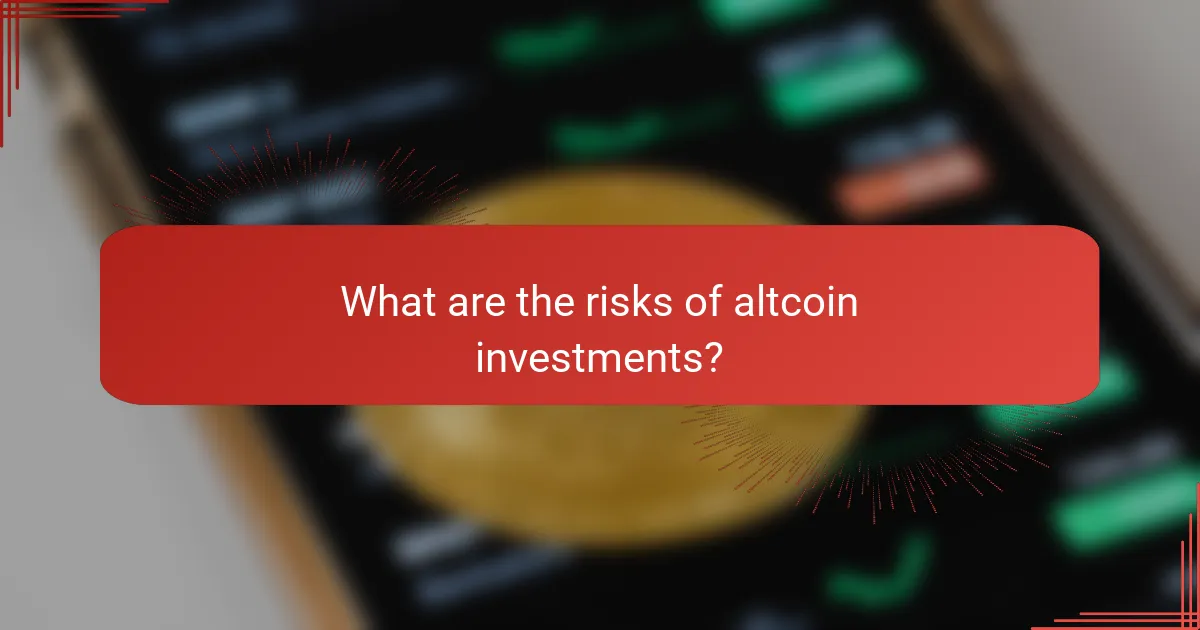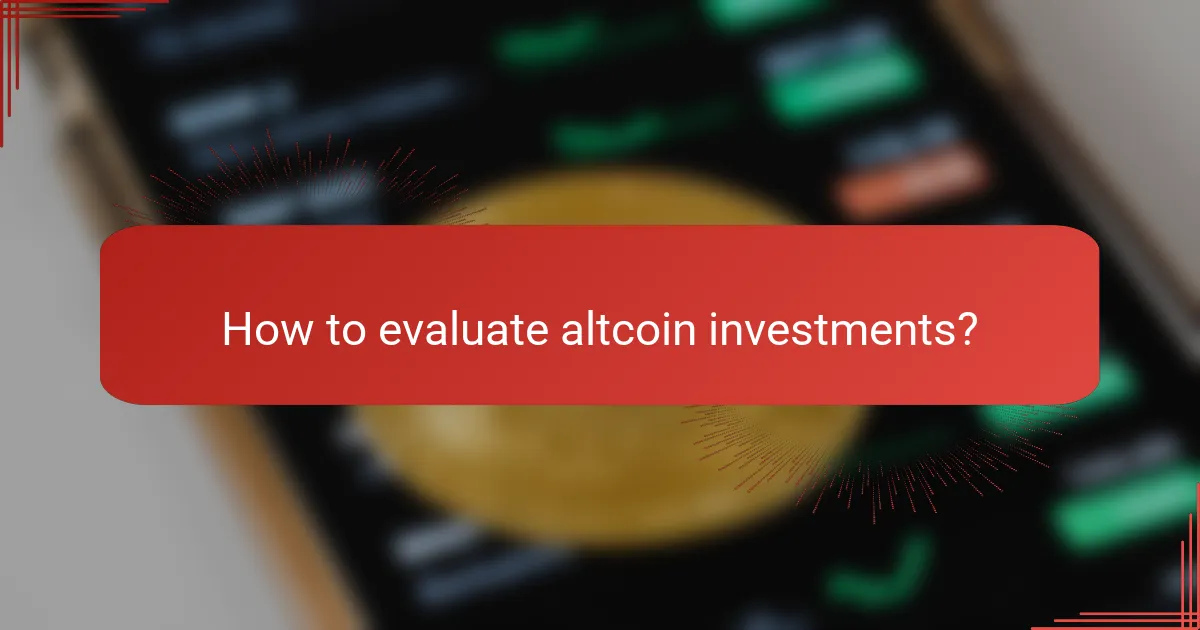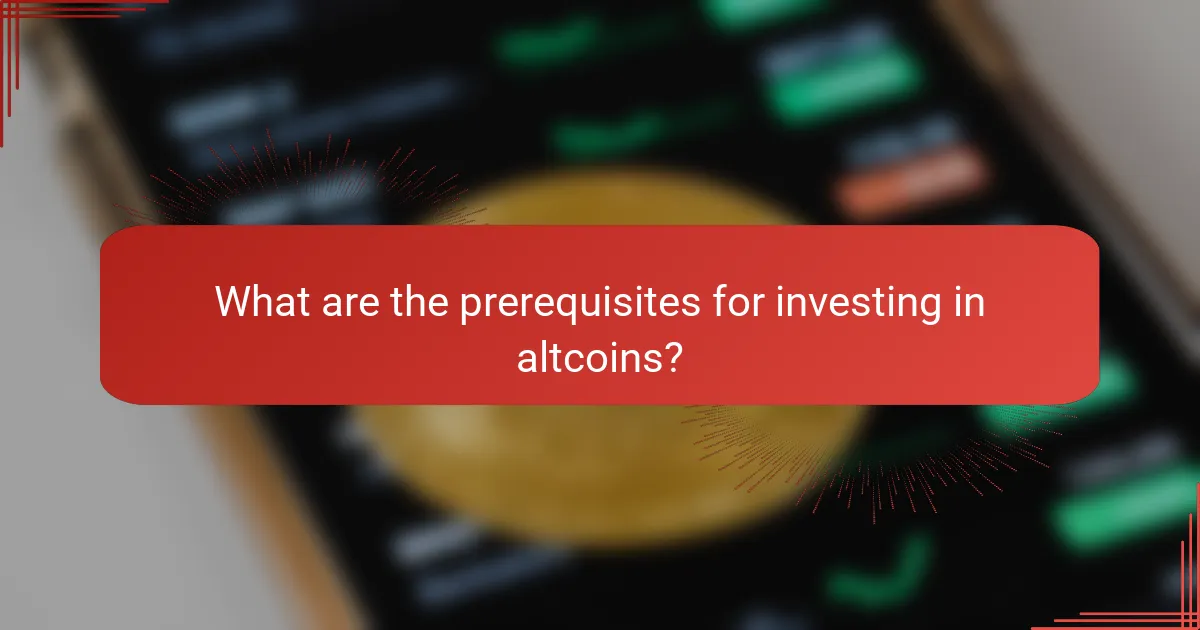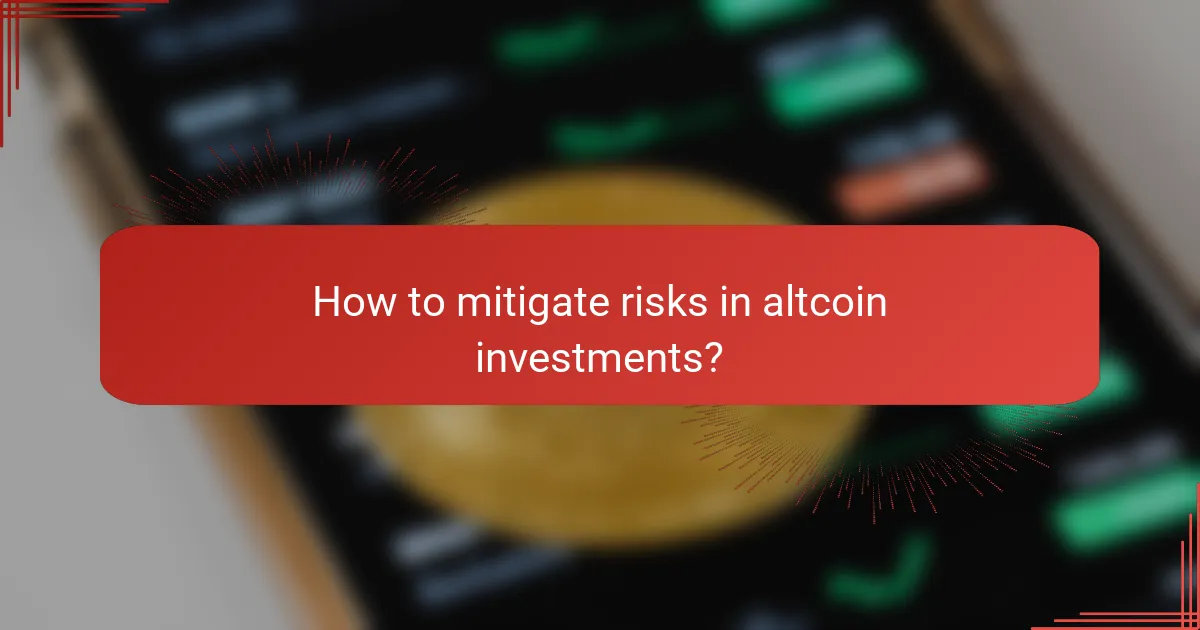Investing in altcoins presents a unique landscape of risk and reward that requires careful consideration. While the potential for high returns and portfolio diversification is enticing, investors must navigate challenges such as market volatility and regulatory uncertainties. Understanding the risk-reward profiles of various altcoins, like Ethereum and Solana, can help investors make informed decisions in this rapidly evolving market.

What are the risks of altcoin investments?
Altcoin investments carry several risks that can significantly impact potential returns. Key risks include market volatility, regulatory uncertainty, and security vulnerabilities, all of which investors should carefully consider before committing funds.
Market volatility
Market volatility refers to the rapid and unpredictable price fluctuations that altcoins often experience. Unlike established cryptocurrencies like Bitcoin, altcoins can see price changes of several percentage points within a single day, leading to potential gains or losses.
Investors should be prepared for this volatility by setting clear investment goals and risk tolerance levels. A common strategy is to allocate only a small portion of a portfolio to altcoins, typically no more than 5-10%, to mitigate the impact of sudden market swings.
Regulatory uncertainty
Regulatory uncertainty is a significant risk for altcoin investors, as governments worldwide are still developing frameworks for cryptocurrency. Changes in regulations can affect the legality and trading of altcoins, potentially leading to losses.
It’s crucial to stay informed about local regulations and any upcoming legislative changes that may impact altcoin markets. Investors should consider diversifying their holdings across different jurisdictions to reduce the risk associated with regulatory shifts.
Security vulnerabilities
Security vulnerabilities pose a serious threat to altcoin investments, as many altcoins operate on less secure platforms compared to major cryptocurrencies. Hacks and scams can lead to substantial financial losses for investors.
To protect investments, use reputable exchanges and wallets with strong security measures, such as two-factor authentication. Regularly updating software and being cautious of phishing attempts can further safeguard assets from potential threats.

What are the rewards of altcoin investments?
Altcoin investments can offer significant rewards, including high potential returns, diversification, and access to cutting-edge technologies. Investors often seek these benefits to enhance their portfolios and capitalize on the evolving cryptocurrency landscape.
High potential returns
Many altcoins have the potential for substantial price appreciation, sometimes yielding returns that far exceed those of traditional investments. For instance, during market surges, certain altcoins can increase in value by hundreds or even thousands of percent within a short period.
However, high potential returns come with increased risk. Investors should be prepared for volatility and consider setting clear profit-taking strategies to lock in gains while minimizing losses.
Diversification opportunities
Investing in altcoins allows for diversification beyond mainstream cryptocurrencies like Bitcoin and Ethereum. By including a variety of altcoins, investors can spread risk across different projects and sectors within the blockchain ecosystem.
To effectively diversify, consider allocating a portion of your investment to various altcoins based on their market capitalization, technology, and use cases. This strategy can help mitigate the impact of poor performance in any single asset.
Access to innovative technologies
Altcoins often represent innovative technologies and solutions that address specific market needs. For example, some altcoins focus on decentralized finance (DeFi), while others may target supply chain management or digital identity verification.
Investors interested in the latest advancements in blockchain technology can benefit from researching and investing in altcoins that align with emerging trends. Staying informed about industry developments can help identify promising projects with long-term potential.

Which altcoins have the best risk-reward profiles?
Altcoins with strong risk-reward profiles typically offer significant growth potential while maintaining manageable risks. Ethereum, Cardano, and Solana are among the most notable options, each with unique features and market positions that influence their risk and reward dynamics.
Ethereum (ETH)
Ethereum is the second-largest cryptocurrency by market capitalization and is known for its smart contract functionality. This platform supports decentralized applications (dApps) and has a robust developer community, which contributes to its stability and growth potential.
Investors should consider Ethereum’s transition to a proof-of-stake model, which aims to improve scalability and reduce energy consumption. However, the network’s high transaction fees can be a drawback during peak usage periods, impacting its attractiveness for smaller transactions.
Cardano (ADA)
Cardano is recognized for its research-driven approach and emphasis on security and sustainability. Its layered architecture allows for greater flexibility and scalability, making it a strong contender in the altcoin space.
While Cardano has shown promise, its slower development pace compared to Ethereum can be a concern for some investors. It’s crucial to monitor its roadmap and upcoming upgrades, as these can significantly influence its market performance and risk-reward profile.
Solana (SOL)
Solana is known for its high throughput and low transaction costs, making it an attractive option for developers and users alike. Its ability to process thousands of transactions per second positions it well for decentralized finance (DeFi) applications and non-fungible tokens (NFTs).
However, potential investors should be aware of Solana’s network outages and the associated risks. While its growth potential is significant, the volatility can lead to sharp price fluctuations, necessitating careful risk management strategies when investing in this altcoin.

How to evaluate altcoin investments?
Evaluating altcoin investments involves analyzing various factors that can influence their potential for profit and risk. Key methods include fundamental analysis, technical analysis, and market sentiment analysis, each providing unique insights into the viability of an altcoin.
Fundamental analysis
Fundamental analysis focuses on the underlying value of an altcoin by examining its technology, use case, and the team behind it. Consider factors such as the project’s whitepaper, community engagement, and partnerships. A strong project typically has a clear purpose and a dedicated development team.
Look for metrics like market capitalization, circulating supply, and total supply to gauge an altcoin’s potential. For example, a low market cap compared to its competitors might indicate room for growth, but it can also signal higher risk. Always compare these metrics against similar projects to get a clearer picture.
Technical analysis
Technical analysis involves studying price charts and trading volumes to predict future price movements of an altcoin. Key indicators include moving averages, Relative Strength Index (RSI), and support and resistance levels. These tools help identify trends and potential entry or exit points for investments.
Use chart patterns like head and shoulders or triangles to spot potential reversals or continuations. A common strategy is to look for altcoins that have recently broken through resistance levels, as this may indicate upward momentum. However, be cautious of false breakouts, which can lead to losses.
Market sentiment analysis
Market sentiment analysis gauges the overall mood of investors towards an altcoin, which can significantly impact its price. This can be assessed through social media trends, news articles, and community forums. Positive sentiment often leads to price increases, while negative sentiment can trigger sell-offs.
Tools like sentiment analysis platforms can provide insights into how the market perceives an altcoin. For instance, a sudden spike in social media mentions might indicate growing interest, while a drop could suggest waning confidence. Always consider sentiment in conjunction with fundamental and technical analyses for a well-rounded evaluation.

What are the prerequisites for investing in altcoins?
Investing in altcoins requires a foundational understanding of blockchain technology, a secure cryptocurrency wallet, and thorough research on various altcoin projects. These prerequisites help mitigate risks and enhance the potential for rewarding investments.
Understanding blockchain technology
Blockchain technology is the backbone of altcoins, enabling secure and transparent transactions. It functions as a decentralized ledger that records all transactions across a network of computers, making it resistant to fraud and manipulation.
Familiarity with key concepts such as smart contracts, consensus mechanisms, and tokenomics is essential. Understanding how these elements work together can help investors assess the viability and innovation of different altcoin projects.
Setting up a cryptocurrency wallet
A cryptocurrency wallet is crucial for storing altcoins securely. There are various types of wallets, including hardware wallets, software wallets, and online wallets, each with different levels of security and accessibility.
When choosing a wallet, consider factors like security features, ease of use, and compatibility with the altcoins you plan to invest in. For example, hardware wallets offer high security but may be less convenient for frequent trading.
Researching altcoin projects
Thorough research on altcoin projects is vital before making investments. Look for information on the project’s whitepaper, team background, community support, and market potential. This can help identify promising projects and avoid scams.
Utilize resources like cryptocurrency forums, news sites, and social media to gather insights. Pay attention to market trends and the project’s roadmap, as these factors can significantly influence the altcoin’s future performance.

How to mitigate risks in altcoin investments?
To mitigate risks in altcoin investments, investors should diversify their portfolios, conduct thorough research, and set clear investment goals. Understanding the volatility and market dynamics of altcoins can help in making informed decisions.
Diversification strategies
Diversification is crucial in managing risk when investing in altcoins. By spreading investments across various cryptocurrencies, investors can reduce the impact of a poor-performing asset. A common approach is to allocate funds to a mix of established coins and promising new projects.
For example, an investor might choose to invest 50% in well-known coins like Bitcoin or Ethereum, 30% in mid-cap altcoins, and 20% in newer, high-risk projects. This strategy helps balance potential losses with gains from more stable assets.
Conducting thorough research
Research is essential before investing in any altcoin. Investors should analyze the project’s whitepaper, team credentials, market potential, and community support. Understanding the technology and use case behind an altcoin can provide insights into its long-term viability.
Utilizing resources like cryptocurrency news websites, forums, and social media can help gather diverse opinions and data. Investors should also be wary of hype and focus on fundamental analysis rather than following trends blindly.
Setting clear investment goals
Establishing clear investment goals is vital for successful altcoin investing. Investors should define their risk tolerance, time horizon, and expected returns. For instance, a short-term trader may focus on quick gains, while a long-term holder might prioritize projects with solid fundamentals.
Regularly reviewing and adjusting these goals based on market conditions and personal circumstances can help maintain a disciplined investment approach. Setting stop-loss orders can also protect against significant losses, ensuring that investors stick to their risk management strategies.


